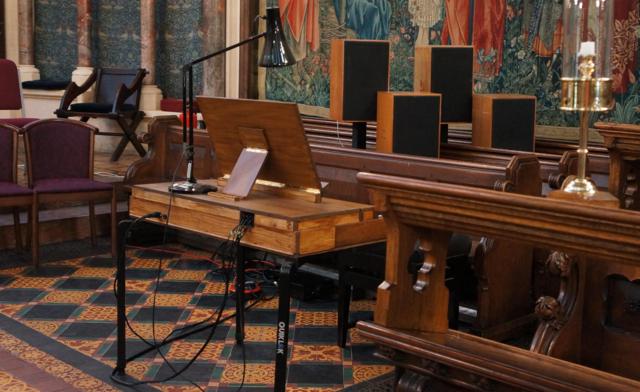My Chamber Organ
A couple of weekends ago my choir gave a concert which required a chamber organ. As we were performing at "baroque" pitch (meaning about a semitone below modern pitch, though actually it varied lots in different places) the fine organ in the church wouldn't do. Hiring a chamber organ at low pitch looked expensive, so I built one using a sampler program specifically for pipe organs, called Hauptwerk, which can transpose the samples to any desired pitch. Here it is in use in Oxford during the rehearsal:

A Dell laptop and MOTU Traveler interface are under the music stand, and a snake takes the signals to an eight-channel volume control on top of three Quad 405 amplifiers stacked behind the four ex-BBC LS5/9 speakers (which were tilted up for the concert). Organ samplers gain realism when the sounds for different pipes are divided among as many speakers as practical, which is why I used four. You can also just see two black speakers, also LS5/9s, behind the choir which had a mono feed to help the singers hear. Rather than give the laptop extra work making the mono mix, I sent the four speaker feeds to ADAT outputs, and looped these back into the ADAT inputs (digital, so no loss); then I used the interface's CueMix program (which operates in the box) to feed the analogue outputs - four with one to one speaker channels, and two with the mono mix of all four channels (and also the last two with a stereo feed for headphone listening while setting up). The sample set used was the positive division of a very old Czech organ in Smecno, near Prague. It was voiced bright in Hauptwerk to compensate for the somewhat unsuitable speakers (they don't have as much treble dispersion as would be ideal in this usage), and tuned down to A=415. The conductor chose it decisively in comparison with several alternatives. It turned out that the organist has a four-manual Hauptwerk system at home, so he wasn't worried about using a substitute for a pipe organ, which had concerned me. Those to whom I've spoken were pleased with the result.
Here's a picture showing the basic construction:

The chamber organ was so successful the first time it was used that we used it again in very our next concert in Exeter College, Oxford chapel. It was mainly used for accompanying Tudor and baroque pieces, some at low pitch (I added a stop button to switch). We also did a movement of Vierne's Messe solonnelle using the chamber organ as the choir organ for the two-organ scoring. I extended the spec with an extra open 8' stop to give a fuller sound for this piece. Here's the organ set up in Exeter College chapel:

Since then we have used the organ for a Handel anthem with a trumpet part. For this I plugged in a separate USB keyboard as a second console, and chose a reasonable trumpet stop for a separate player to play on it - leaving the main keyboard for the usual continuo use.

